
Cryptaspasma querula is a moth of the family Tortricidae. It is endemic to New Zealand and can be found throughout the country. This species inhabits podocarp and broadleaf forest. The larvae consume parts of the seeds and fruits of tawa, tarairi and miro trees and are predated upon by the invasive to New Zealand house mouse. Larvae pupate in leaf litter under their host trees. Adults are variable in appearance and also in size. They are on the wing throughout the year and are nocturnal but are attracted to light. They can be found having flown inside houses and have also been observed resting on fences or other human made structures during the day.

Izatha apodoxa is a moth of the family Oecophoridae. It is endemic to New Zealand, where it is known from scattered localities in the southern North Island. This species is variable in appearance and comes in two forms, a grey form and a black and white form. In the grey form it is very similar in appearance to I. notodoxa and in the black and white form to I. katadiktya. At present the larvae and biology of this species is unknown.
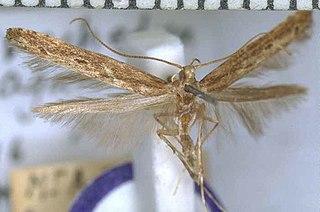
Batrachedra agaura is a species of moth in the family Batrachedridae. It is endemic to New Zealand. This species is distributed throughout the country. The species inhabits native forests, especially beech and kanuka forests or manuka scrubland. The larvae of this species are associated with sooty mold and sooty beech scale. It has been hypothesized that the larvae feed on sooty beech scale. However, they may also feed on the sooty mold itself. The adult female is lighter in appearance than the male, and the species shows considerable variation in patterns on the forewing. Adults are on the wing from October to February. They are nocturnal and occasionally attracted to light.
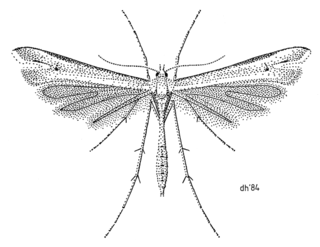
Amblyptilia lithoxesta is a moth of the family Pterophoridae. It is endemic to New Zealand. It was first described by Edward Meyrick in 1885. This species inhabits rough herbage on mountain sides. Larvae feed on Veronica buchananii. Adults are on the wing in January.

Ichneutica scutata is a moth of the family Noctuidae. It is endemic to New Zealand. This species can be found in the southern parts of the North Island as well as the eastern parts of the South Island. It is similar in appearance to I. insignis and I. skelloni but can be distinguished as I. scutata is much paler in appearance. It is likely this species inhabits lowland tussock grasslands as well as coastal dunes although it is not common in inland tussock grasslands. The larvae feed on a variety of herbaceous plants such as Plantago and Convolvulus species, Plagianthus divaricatus. It pupates on soil near its host plants. The adults are on the wing from late March to July.

Chersadaula ochrogastra is a species of moth in the family Oecophoridae. This species is endemic to New Zealand. It is classified as "Data Deficient" by the Department of Conservation.
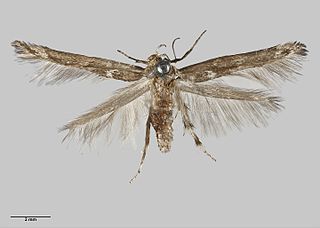
Stathmopoda albimaculata is a species of moth in the Stathmopodidae family. It is endemic to New Zealand and is located in the lower half of the South Island. This species favours habitat that includes the various Olearia species that host its larvae. It has also been found to inhabit lowland podocarp native forest. The larvae feed on species in the genus Olearia. Adults are on the wing between the months of October and February. S. albimaculata is classified as Nationally Endangered by the Department of Conservation.

Archyala lindsayi is a species of moth in the family Tineidae. This species is endemic to New Zealand. It is classified as "At Risk, Naturally Uncommon" by the Department of Conservation.

Eurythecta phaeoxyla is a species of moth of the family Tortricidae. It was described by Edward Meyrick in 1938. It is endemic to New Zealand and has been observed in the Canterbury and Otago regions. The preferred habitat of this species is alpine swampy areas. The larvae feed on herbs and adults are on the wing in February.
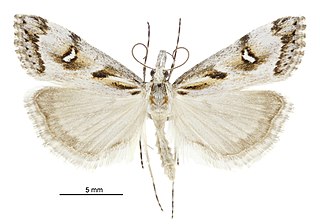
Gadira leucophthalma, the beaked moss moth, is a moth in the family Crambidae. It is endemic to New Zealand. It is found in the south eastern side of the South Island down to Banks Peninsula. G. leucophthalma inhabits the foredunes of coastal areas. The larval host is unknown but it has been hypothesised that the larvae feed on moss. The adult moths are day flying although some specimens have been trapped at night via light traps. Adults are commonly on the wing from March to April. This species has been classified as Nationally Vulnerable by the Department of Conservation.

Pyrgotis eudorana is a species of moth of the family Tortricidae. It is endemic in New Zealand and has been observed in both the North and South Islands. However it is regarded as a rare insect. This species inhabits native forest. Larvae exclusively feed on Muehlenbeckia australis and adults are on the wing from November to April. Adults are attracted to light.

Pyrgotis transfixa is a species of moth of the family Tortricidae. It is endemic to New Zealand. It is classified as "At Risk, Naturally Uncommon" by the Department of Conservation.

Pyrgotis zygiana is a species of moth of the family Tortricidae. It is endemic to New Zealand.
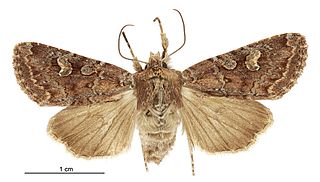
Ichneutica agorastis is a moth of the family Noctuidae. This species is endemic to New Zealand. This moth is similar in appearance to two other species in the genus but can be distinguished through the colour and size of its forewings. This species is found in the South Island and Stewart Island in open habitats in the subalpine zone. However, in Southland I. agorastis can be found down to sea-level. Adult moths are on the wing between January and April. The life history and host species are unknown.
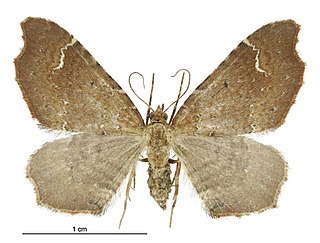
Asaphodes camelias is a species of moth in the family Geometridae. It is endemic to New Zealand, has been observed in both the North and South Islands and inhabits native forest. The adults of this species are on the wing from February to May and July to September.

Archyala culta is a species of moth in the family Tineidae. This species is endemic to New Zealand. It is classified as "Data Deficient" by the Department of Conservation. This species has only been collected at Opoho and is only known from its type specimen.
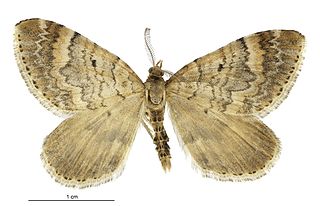
Asaphodes dionysias is a species of moth in the family Geometridae. This species is endemic to New Zealand and is only known from mountainous areas in Central Otago. It lives in open grassy mountainous habitat at altitudes up to 1750 m. It is also known to live in wetland habitat. The larvae of this species feed on native herbs. The adults of this species are on the wing in January and February. The adult female of the species has reduced wing size in comparison to the male.
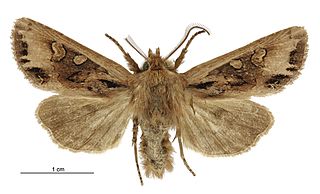
Ichneutica fenwicki is a moth of the family Noctuidae. This species is endemic to New Zealand and is found in the southern parts of the South Island and on Stewart Island. It is a distinctively coloured moth that is unlikely to be confused with closely related species. It is a spring flying moth being on the wing from September to November. The life history and host species of the larvae of I. fenwicki are unknown.
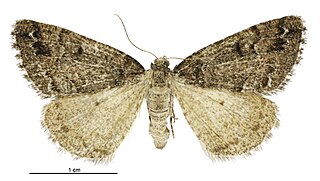
Pseudocoremia colpogramma is a species of moth in the family Geometridae. This species was described by Edward Meyrick in 1936. It is endemic to New Zealand.

Trachypepla spartodeta is a moth of the family Oecophoridae first described by Edward Meyrick in 1883. It is endemic to New Zealand and has been collected in both the North and South Islands. This species inhabits native forest and adults are on the wing from November to January.





















